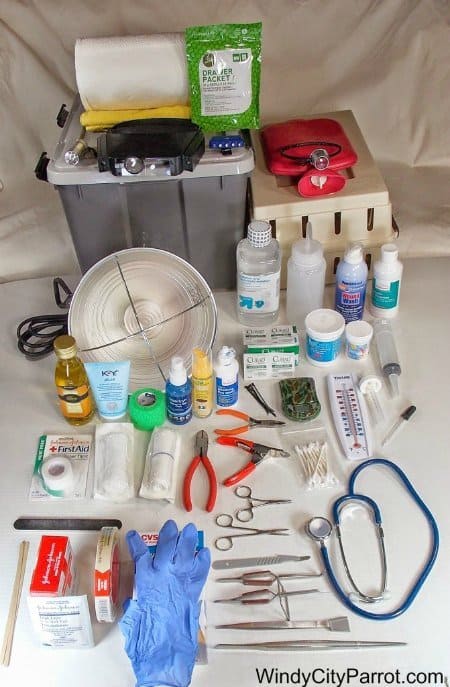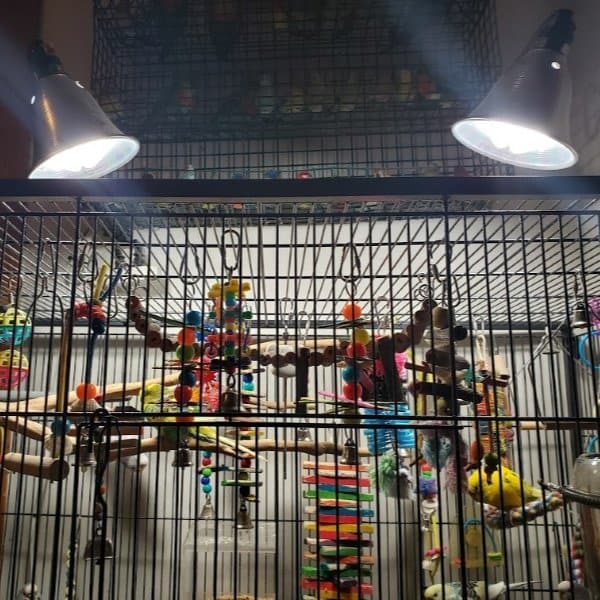Last Updated on by Catherine Tobsing
The products you find in this category include solutions for – keeping beaks trim – first aid – restraint – feather and nail grooming – lighting – weight tracking – training – hormonal issues.
Believe me when I tell you that when you have a pet bird in your home for decades, you will need products from all seven categories.
Let’s look at each one.
Keeping beaks trimmed
The single most important body part of a bird is its beak.
A bird uses it for foraging, eating, drinking water, climbing, and self-defense.
With nothing to scrape it on so as to keep it sharp and clean (think about a chef sliding his knife against a honing steel) the bird might not be able to negotiate thick-shelled nuts as an example.
Contrary to what many people think, parrot’s beaks are not simply a solid piece of keratin, have thousands of cells known as Copusles of Herbst making it extremely sensitive and something that should never get pet.
A grooming perch placed near a food dish will give your bird a place to rub it while eating because it likes to remove the particles that stick to it.
First aid
If humans never needed first aid we wouldn’t need emergency rooms hospitals and doctors.
Your bird will have a medical emergency at some point in its life.
The injury might be big and or it might be small but are you ready to pull a blood feather or stop the bleeding on a toe with a toenail was cut too short?

Learn more about the biggest and best pet bird first aid kit ever built by Windy City Parrot
Which brings us to
Weight tracking
One of the best survival skills parakeets and parrots have is hiding any illness.
Sure, sometimes you’ll notice a discharge from the and nare or the eyes.
Monitoring the condition of your bird’s poop can say a lot.
The simplest thing you can do is to weigh your bird regularly, at least twice a month.
This will indicate any rapid changes in weight which is always the first sign of a physical ailment
Restraint
I know a lot of people get nauseous when I think about trying to restrain their birds but you really have to look at this pragmatically.
If your bird has an injury it’s going to need an examination by you or a veterinarian.
It’s important that your bird knows that towels are friendly and not something to be scared about.

Pivoting on the subject of restraint, if for any reason you are asked to evacuate due to fire, flooding or a human threat, do you really want to be chasing your bird whos hiding under the bed as class 4 hurricane is approaching?
Feather and nail grooming.
Full transparency we are advocates of keeping birds flighted.
If you want to trim your bird’s wings we will help you do that because chances are whoever else does it is procedurally incorrect and could possibly harm your bird in unexpected ways.
It’s imortant to remember that birds not only use their wings for flight but also for balance.
Trim your bird’s wings and toenails then return them back into their birdcage, covering for the night is a recipe for disaster.
You have increased the odds of falling off a perch triggered a night fright (sudden and unexpected loud noise) and then suffers injury while it uncontrollably flaps while falling to the bottom of the cage because it couldn’t hang on to its sleeping perch.
Training
Your bird doesn’t have to have enough training to perform for the circus but wouldn’t it be nice to have some control rather than always relying on the bird wants to do?
Proper lighting is essential for your bird’s physical and mental health.
Far too many people get hung up in terms like Lumens, LUX, CRI and Kelvin.
The reality is that light cycle is far more important than the quality of light.
Pet birds cannot get the signals natural sunlight provides without having access to natural sunlight from dawn till dusk which is usually impractical.
We keep our birds in tiny cages, in tiny rooms when compared to the 30 to 50 acre area that they instinctually expect and then we wonder why we fail.

By simply placing a light no higher than 6 inches above the cage put it in on a timer with 12 hours of daylight and 12 hours of darkness which determines the beginning of morning and end of the day (night) for your bird and will do wonders towards evening them emotionally.
We have been successful in shutting down prolific eight egg-laying birds using extended light cycles instead of toxic drugs like Lupron which you can read about here.
Hormonal issues
Your bird gets a lot of signals from the light around it.
Light can tell a bird when to molt, when to mate and when to migrate (when applicable).
By not controlling this we end up with people who can’t handle the birds because they are plucking or screaming.
Allow me to publish some of the things that we have learned about solving hormonal problems in pet birds.
A woman replying in a Facebook thread about her self-mutilating parrot “my vet said that it’s become a habit that’s it very hard to break”.
My response was “Ask your vet why these habits don’t develop in the wild”?
Another woman had spent $4000 between veterinarian bills and behaviorists.
Her bird was still plucking.
In the thread that evolved it turns out that her cages were filled primarily eucalyptus perches.
Although eucalyptus can be safe it also has a great many toxins that can be lethal to a bird.
She also related that her bird got about one hour of daylight – none of this came up in the conversation with her veterinarian or behaviorist.
Other threads related how the veterinarian had injected the bird with who knows what?
One woman was going to try to serve her bird every spice known to mankind.
When you connect the dots you have to ask yourself if veterinarians could cure feather mutilation with some injections or humans could stop the bird with plucking by changing their diet, why have we not seen a cure for plucking.
Shameless self-promotion here.
Windy City Parrot is the only site on the Internet that actually has a category devoted specifically to tools to help plucking and screaming birds that you can find here.
Both of veterinarians and the bird companions talk about nothing but treatment and yet we hear no discussion about plucking triggers.
I’ve compiled a shortlist to help steer you in the right direction.
If you have a plucking bird would like some help we’d be happy to.
What we won’t respond to is “my bird is plucking please help!”
That tells us nothing.
What we need to know and have you look at are the top 10 feather plucking triggers listed below.
Some may even create and Ah-Ha moment for you.
10 Feather plucking triggers
- Nutrition (based diet) – are we looking at the possibility of food allergies? Are we eating too many seeds?
- Nutrition (chops) do we know the actual nutritional value of the chops we are making? Store-bought fruit has much more sugar than fruit eaten in the wild. Are we serving our birds citrus fruit like oranges and pineapples that sit in their crop for up to six hours possibly causing heartburn? Is your bird getting enough protein – what the nutritional analysis of your chop?
- Habitat (cage) – does the birdcage offer a privacy area? Are there foraging/enrichment opportunities in and atop the cage? Is the bird sleeping on a soft rope perch or are his or her feet being irritated by sleeping on the wrong kind of perch?
- Habitat (home) does your bird have a place to be with you within the home so he or she is not eating furniture? Do you have enrichment and foraging activities outside of the cage? Do you burn candles or use air fresheners?
- Habitat (lighting) is your bird getting 12 hours of light and 12 hours of darkness or are you relying on North American ever-changing light cycles to thoroughly confuse and cripple your bird’s circadian clock?
- Habitat (change) – are we rearranging our bird’s cage at least every 30 days causing them to rethink their entire environment and distracting them from things like plucking their own feathers?
- Habitat (flock) – What is the interpersonal relationships between your bird and other members of the family including other pets?
- Bird (interpersonal) – is there an issue between your bird and other human flock members? Did you recently move a piece of furniture or picture on the wall (yes that can be a plucking trigger? Any issues with other animals in the home?
- Bird (physiological) – Is your bird clipped meaning it has at least 16 of its biggest feathers with rough edges that need to be fixed (preened – leading to plucking)? It no longer has a strong sense of balance -which is stressful
- Clean – are we exposing our bird to any sort of bathing and/or misting to enable adding hydration to their fathers? Is there a humidifier in the home? Are you using the wrong cleaning products like Lysol (recommend by a bird “expert” on YouTube)?
Written by Mitch Rezman
Approved by Catherine Tobsing
